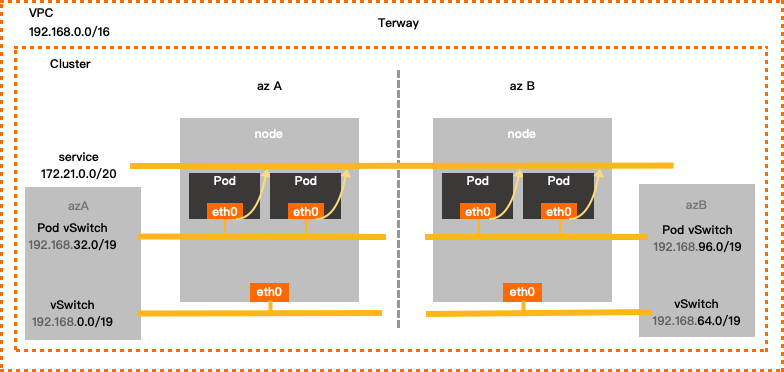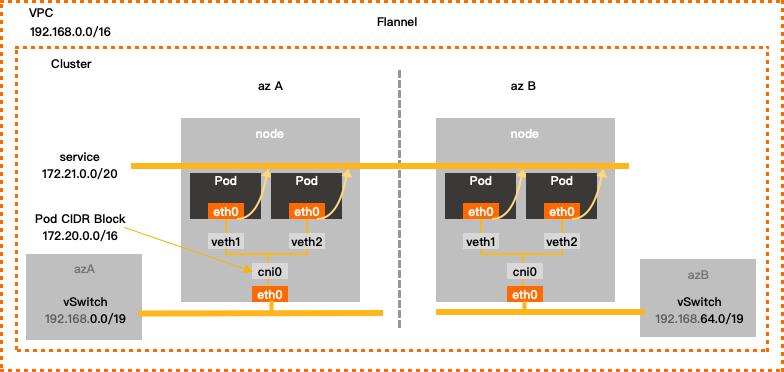Parameter | Terway | Flannel |
VPC | When you create a VPC, you must select a CIDR block for the VPC. Valid values: 10.0.0.0/8, 172.16.0.0/12, and 192.168.0.0/16.
IPv6 CIDR blocks are assigned by the VPC after you enable IPv6 for the VPC. If you want to enable IPv6 for containers, select Terway for the Network Plug-in parameter. |
vSwitch | The vSwitches associated with ECS instances allow nodes to communicate with each other. The CIDR blocks of vSwitches in the VPC must be subsets of the VPC CIDR block. This indicates that the CIDR blocks of vSwitches must be the same as or fall within the VPC CIDR block. When you specify the CIDR blocks of vSwitches, take note of the following items:
You must select vSwitches that belong to the VPC in which the cluster resides. The system allocates IP addresses from the CIDR block of a vSwitch to the ECS instances that are associated with the vSwitch. You can create multiple vSwitches in a VPC. However, the CIDR blocks of these vSwitches cannot overlap with each other. The pod vSwitches and vSwitches must be deployed in the same zone. For more information about zones, see Regions and zones.
| The vSwitches associated with ECS instances allow nodes to communicate with each other. The CIDR blocks of vSwitches in the VPC must be subsets of the VPC CIDR block. This indicates that the CIDR blocks of vSwitches must be the same as or fall within the VPC CIDR block. When you specify the CIDR blocks of vSwitches, take note of the following items:
You must select vSwitches that belong to the VPC in which the cluster resides. The system allocates IP addresses from the CIDR block of a vSwitch to the ECS instances that are associated with the vSwitch. You can create multiple vSwitches in a VPC. However, the CIDR blocks of these vSwitches cannot overlap with each other.
|
Pod vSwitch | The IP addresses of pods are assigned from the CIDR blocks of pod vSwitches. This allows pods to communicate with each other. Pod is an abstraction in ACK. Each pod has an IP address. The CIDR blocks that you specify when you create pod vSwitches in the VPC must be subsets of the VPC CIDR block. When you specify the CIDR blocks of pod vSwitches, take note of the following items:
You must select vSwitches that belong to the VPC in which the cluster resides. In an ACK cluster that uses Terway, the IP addresses of pods are assigned by pod vSwitches. The CIDR blocks of pod vSwitches cannot overlap with the Service CIDR block. The pod vSwitches and vSwitches must be deployed in the same zone. For more information about zones, see Regions and zones.
| You do not need to configure this parameter if your cluster uses Flannel. |
Pod CIDR Block | You do not need to configure this parameter if your cluster uses Terway. | The IP addresses of pods are allocated from the pod CIDR block. This allows pods to communicate with each other. Pod is an abstraction in ACK. Each pod has an IP address. When you specify the pod CIDR block, take note of the following items:
Enter a CIDR block in the Pod CIDR Block field. The pod CIDR block cannot overlap with the CIDR blocks of vSwitches. The CIDR blocks of pod vSwitches cannot overlap with the Service CIDR block.
For example, if the VPC CIDR block is 172.16.0.0/12, the pod CIDR block cannot be 172.16.0.0/16 or 172.17.0.0/16 because these CIDR blocks are subsets of 172.16.0.0/12. |
Service CIDR | The CIDR block of Services. Service is an abstraction in ACK. The IP addresses of ClusterIP Services are allocated from the CIDR block of Services. Each ClusterIP Service has an IP address. The IP address of a Service is effective only within the ACK cluster. The CIDR block of Services cannot overlap with the CIDR blocks of vSwitches. The CIDR block of Services cannot overlap with the CIDR blocks of Pod vSwitches.
| The CIDR block of Services. Service is an abstraction in ACK. The IP addresses of ClusterIP Services are allocated from the Service CIDR block. Each ClusterIP Service has an IP address. The IP address of a Service is effective only within the ACK cluster. The Service CIDR block cannot overlap with the CIDR blocks of vSwitches. The Service CIDR block cannot overlap with the pod CIDR block.
|
IPv6 Service CIDR | If you enable IPv6 dual-stack, you must specify an IPv6 CIDR block for Services. When you specify the IPv6 CIDR block, take note of the following items:
You must specify a unique local address (ULA) space within the address range fc00::/7. The prefix must be 112 bits to 120 bits in length. We recommend that you specify an IPv6 CIDR block that has the same number of IP addresses as the Service CIDR block.
| You do not need to configure this parameter if your cluster uses Flannel. |
 Elastic Compute Service (ECS)
Elastic Compute Service (ECS)
 Container Compute Service (ACS)
Container Compute Service (ACS)






















